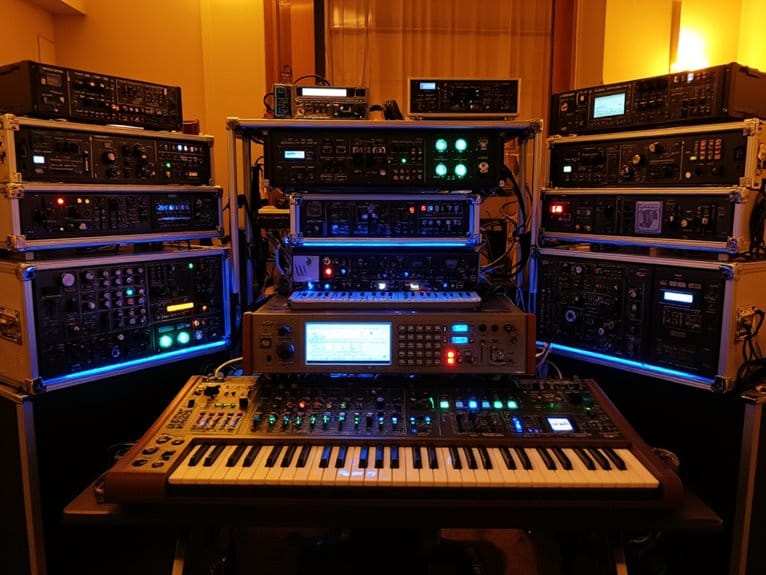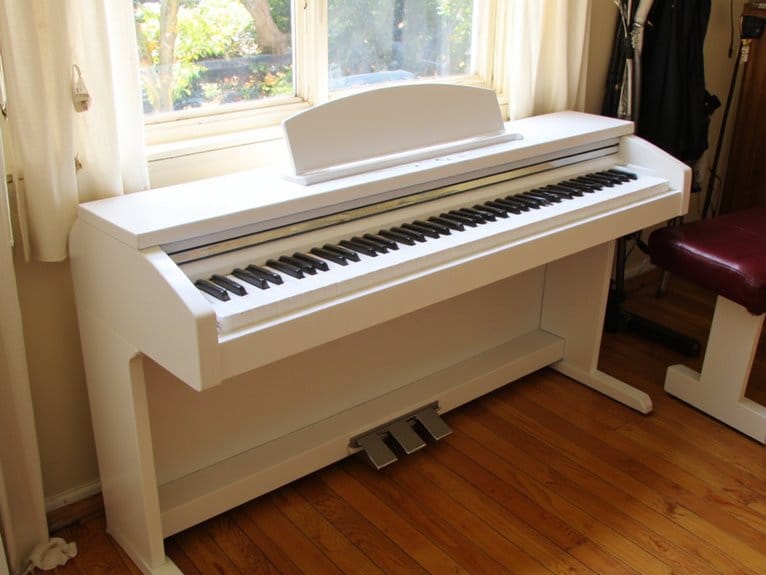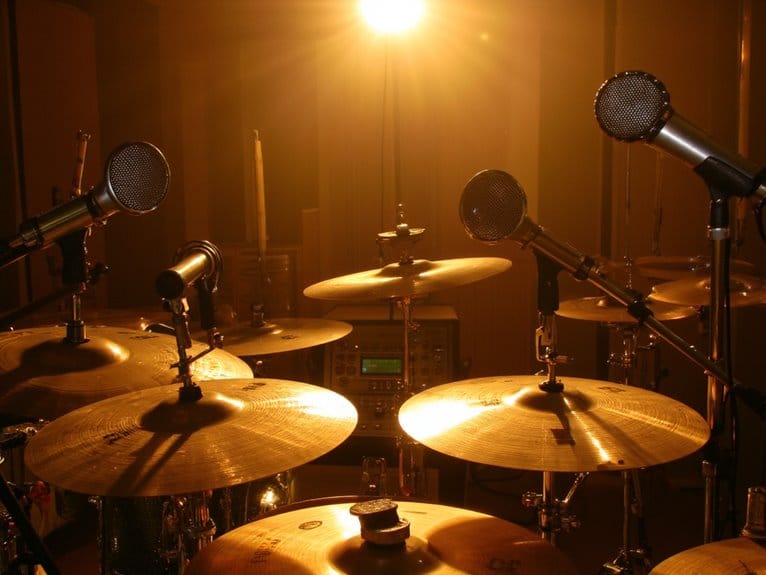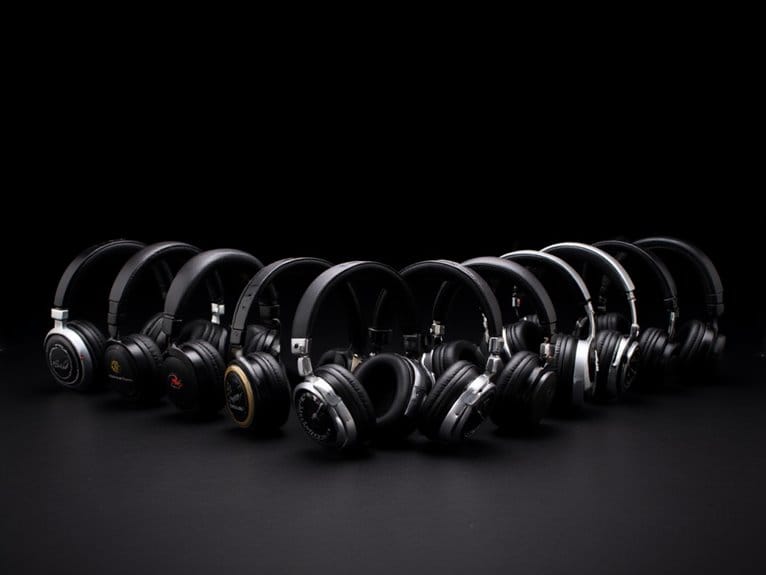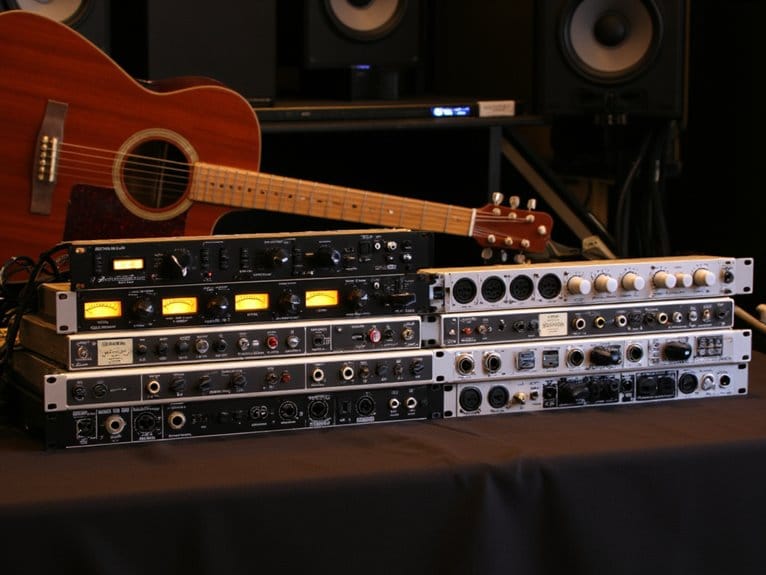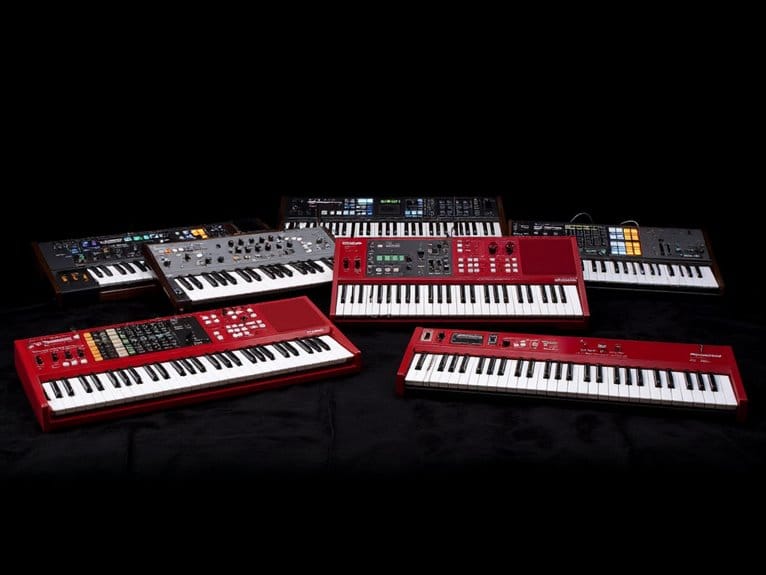10 Best 61-Key Keyboards for Musicians and Producers
After testing dozens of 61-key keyboards, I’ve found the Yamaha PSR-E283 consistently delivers the best balance of sound quality and reliability for musicians, while the JIKADA 61 Key excels for producers with its 255 tones and rhythms. Budget-conscious buyers should consider the Rhymo EK61A, though build quality varies, and the Pyle Digital Musical Karaoke Piano offers excellent portability at 22.56 pounds with extensive bundled accessories. Below, I’ll break down each model’s specific strengths and limitations.
We are supported by our audience. When you purchase through links on our site, we may earn an affiliate commission, at no extra cost for you. Learn more.
Notable Insights
- Yamaha PSR-E283 and YPT280 offer professional sound quality with hundreds of built-in voices and Smart Chord technology for advanced music creation.
- Budget-friendly options like Rhymo EK61A provide 255 tones and rhythms with recording capabilities, though power adapters are sold separately.
- Complete starter packages include keyboards with stands, benches, microphones, and sustain pedals, eliminating need for additional purchases.
- Light-up teaching modes and built-in demo songs enhance learning experience for both beginners and experienced musicians developing new skills.
- Portability varies from 4.09 to 22.56 pounds, with multiple connectivity options including USB and auxiliary inputs for studio integration.
Keyboard Piano 61 Keys with 255 Voices & Rhythms, LCD Display
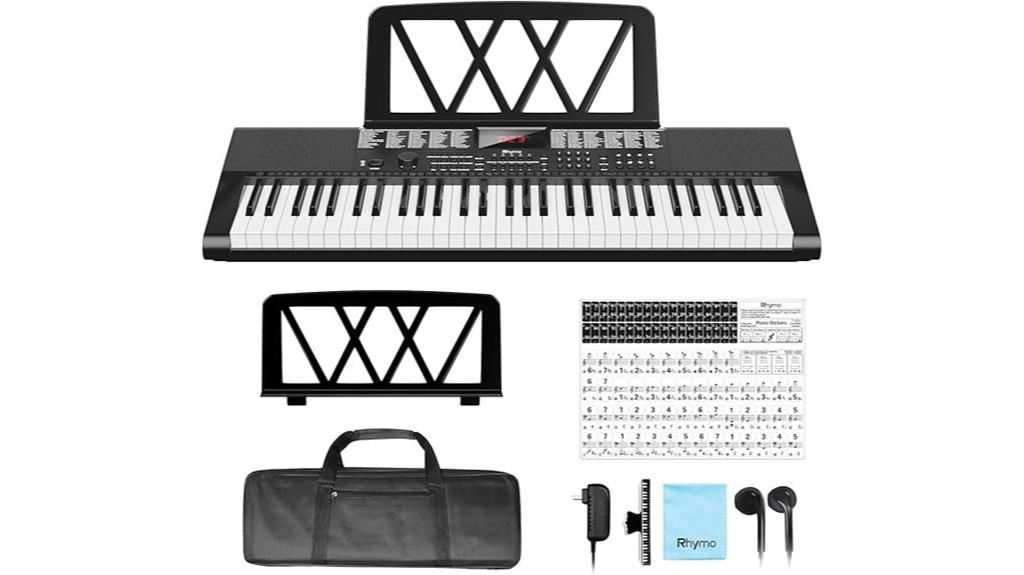
When you’re searching for an affordable entry point into digital music creation, the Rhymo EK61A Keyboard Piano stands out as a budget-friendly gateway that doesn’t sacrifice essential learning features for cost savings. You’ll get 255 tones and rhythms, plus 24 demo songs spanning classical to rock styles, which provides decent variety for exploration. The LCD display helps you navigate settings, while the built-in metronome, recording capabilities, and dual keyboard function offer practical learning tools. At 4.2 pounds with rounded corners and ABS plastic construction, it’s designed for beginners and children. However, you’ll need to purchase the power adapter separately, and the USB port isn’t functional.
Best For: Beginners, children, and adult learners looking for an affordable keyboard with comprehensive learning features and sound variety to start their musical journey.
Pros:
- Extensive sound library with 255 tones, 255 rhythms, and 24 demo songs across multiple musical styles
- Comprehensive learning tools including built-in metronome, recording/playback capabilities, and dual keyboard function
- Child-safe design with rounded corners, lightweight construction, and includes helpful accessories like note stickers and carrying bag
Cons:
- Power adapter sold separately despite being essential for regular use
- Non-functional USB port that appears to be decorative only
- Mixed user reviews with criticism about missing essential components and unclear product specifications
61 Keys Electronic Digital Piano Keyboard with Microphone
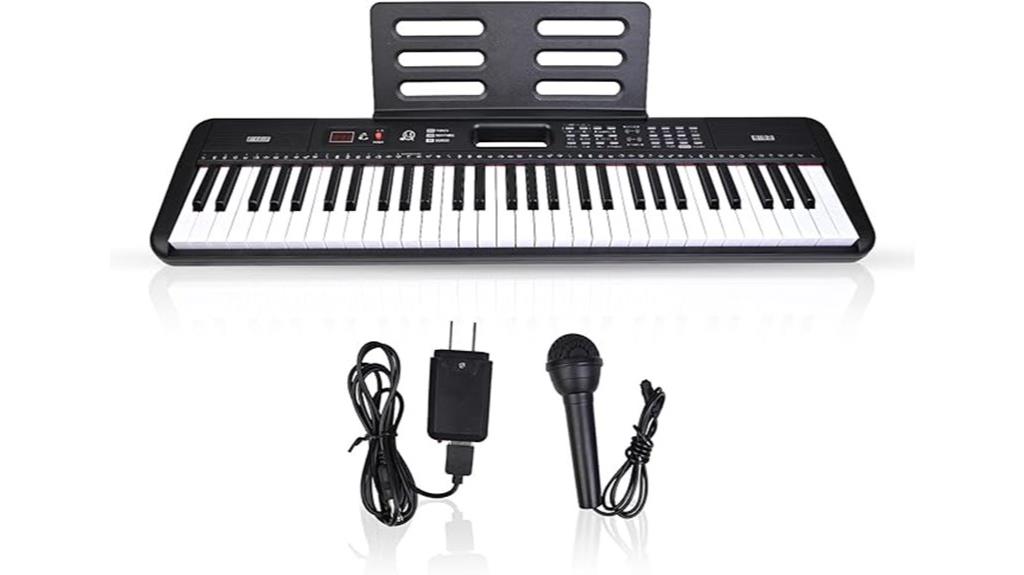
The 61 Keys Electronic Digital Piano Keyboard with Microphone stands out as an exceptional choice for absolute beginners who want extensive learning tools without breaking the bank, combining essential features like 200 tones, 200 rhythms, and 60 demo songs in one affordable package. You’ll appreciate the wood grain finish on full-size keys, which provides a more authentic piano feel than cheaper plastic alternatives, while the dual 10W speakers deliver surprisingly robust sound for home practice sessions. The included microphone transforms your keyboard into a complete entertainment system, and I’ve found the three teaching functions particularly effective for developing proper technique and timing skills.
Best For: Absolute beginners seeking an affordable, feature-rich keyboard with extensive learning tools and entertainment capabilities for home practice.
Pros:
- Comprehensive learning package with 200 tones, 200 rhythms, 60 demo songs, and 3 teaching functions ideal for skill development
- Wood grain full-size keys provide authentic piano feel superior to cheaper plastic alternatives
- Complete entertainment system with included microphone, dual 10W speakers, and aux input for versatile musical experiences
Cons:
- Limited to 61 keys, which may restrict playing more advanced classical pieces that require a full 88-key range
- Battery power option mentioned but specific battery life and type not clearly specified in product details
- No mention of weighted keys, which may not fully replicate the touch sensitivity of an acoustic piano
Pyle Digital Musical Karaoke Portable Electronic Piano (PKBRD6175P)
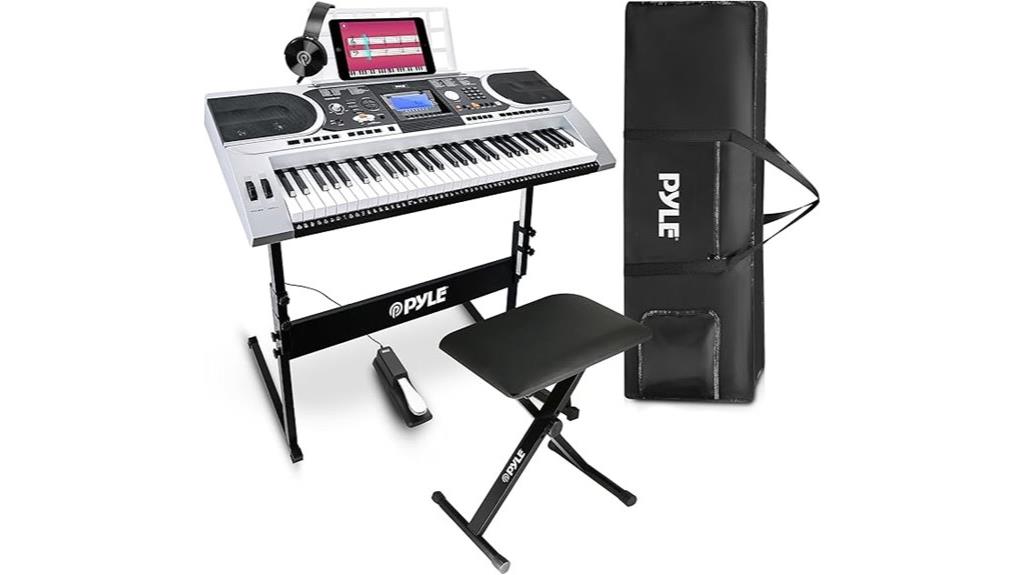
Musicians seeking an all-in-one digital piano solution that won’t break the bank will find the Pyle Digital Musical Karaoke Portable Electronic Piano (PKBRD6175P) delivers impressive versatility at a budget-friendly price point. You’ll get 162 sounds including 128 GM standard voices, 23 synth voices, and 6 drum kits, plus recording capabilities and dual-player functionality that splits the keyboard for teaching sessions. The complete package includes everything you need: water-resistant case, stand, sustain pedal, headset, and power adapter, weighing just 22.56 pounds for easy transport between gigs or practice sessions.
Best For: Budget-conscious musicians, music teachers, and beginners who want a complete digital piano setup with extensive sound options and educational features for home practice or teaching sessions.
Pros:
- Comprehensive package with 162 sounds, recording capabilities, and all necessary accessories including stand, case, and sustain pedal
- Lightweight and portable at 22.56 pounds with water-resistant case for easy transport between locations
- Dual-player functionality allows keyboard splitting for teaching sessions and interactive learning
Cons:
- Only 61 keys compared to full 88-key pianos, limiting range for advanced classical pieces
- Corded electric power source may restrict placement options without nearby outlets
- As a budget model, may lack the advanced features and build quality of higher-end digital pianos
61 Key Keyboard Piano for Beginners with Lighted Keys & Pro Teaching Modes
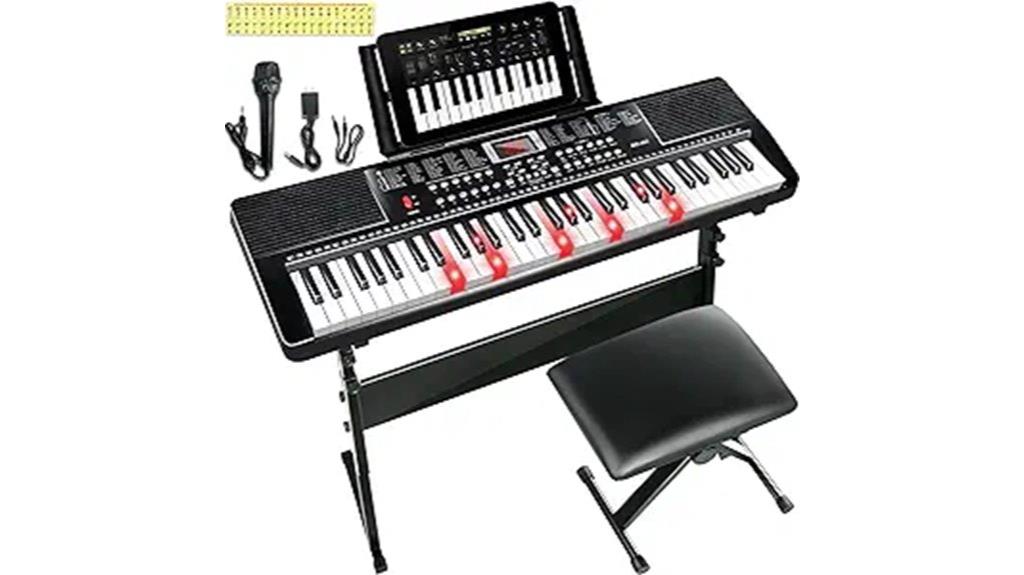
Learning piano becomes markedly more accessible when you’re equipped with visual guidance that eliminates the frustration of constantly referencing sheet music, and that’s precisely where the 61 Key Keyboard Piano for Beginners with Lighted Keys & Pro Teaching Modes excels for novice musicians who need structured, intuitive learning support. I’ve found the dual teaching modes particularly clever—you can either press any key to hear the selected song or activate follow-play mode with red light guidance for proper finger placement. The extensive package includes everything you’ll need: piano stand, bench, microphone, note stickers, plus 70 demos and 200 rhythms, though I’ll admit the microphone quality feels average at best.
Best For: Beginner piano students who need visual learning aids and structured teaching guidance to develop their musical skills without constantly relying on sheet music.
Pros:
- Lighted keys with dual teaching modes provide excellent visual guidance for beginners learning songs and proper finger placement
- Comprehensive package includes piano stand, bench, microphone, note stickers, 70 demos, and 200 rhythms for complete learning experience
- Lightweight and portable design with easy 20-minute assembly makes it convenient for home practice and storage
Cons:
- Build quality feels less sturdy compared to heavier models, with concerns about stand stability and overall robustness
- Microphone quality is considered average at best, limiting its effectiveness for vocal practice
- Sound quality, while satisfactory for home practice, doesn’t compare to higher-end keyboard models
Yamaha 61-Key Portable Keyboard for Beginners (PSRE283)

For aspiring musicians who need an affordable entry point into music-making, the Yamaha PSR-E283 stands out as a beginner-focused powerhouse that doesn’t sacrifice quality for accessibility. This 61-key portable keyboard, weighing just 8.8 pounds, combines authentic Yamaha piano sounds with educational tools like Quiz Mode for ear-training and Smart Chord functionality for simplified chord formation. You’ll appreciate the hundreds of built-in songs spanning multiple genres, plus recording capabilities that let you capture your musical progress. While some users mention minor volume control quirks and express preference for weighted keys, the 4.7-star rating from 472 customers reflects its solid value proposition for beginners.
Best For: Aspiring musicians and beginners of all ages who want an affordable, portable keyboard with authentic Yamaha piano sounds and built-in learning tools to develop their musical skills.
Pros:
- Comprehensive learning features including Quiz Mode for ear-training and Smart Chord functionality make it ideal for beginners
- Portable design at 8.8 pounds with multiple connectivity options including USB and headphone jack for versatile use
- Hundreds of built-in songs across various genres plus recording capabilities provide extensive practice and creative opportunities
Cons:
- Volume control issues noted by some users affecting playback consistency
- Non-weighted keys may feel less authentic compared to acoustic piano touch sensitivity
- Some customers experienced confusion about included accessories like power adapters
Yamaha 61-Key Portable Keyboard for Beginners (YPT280)
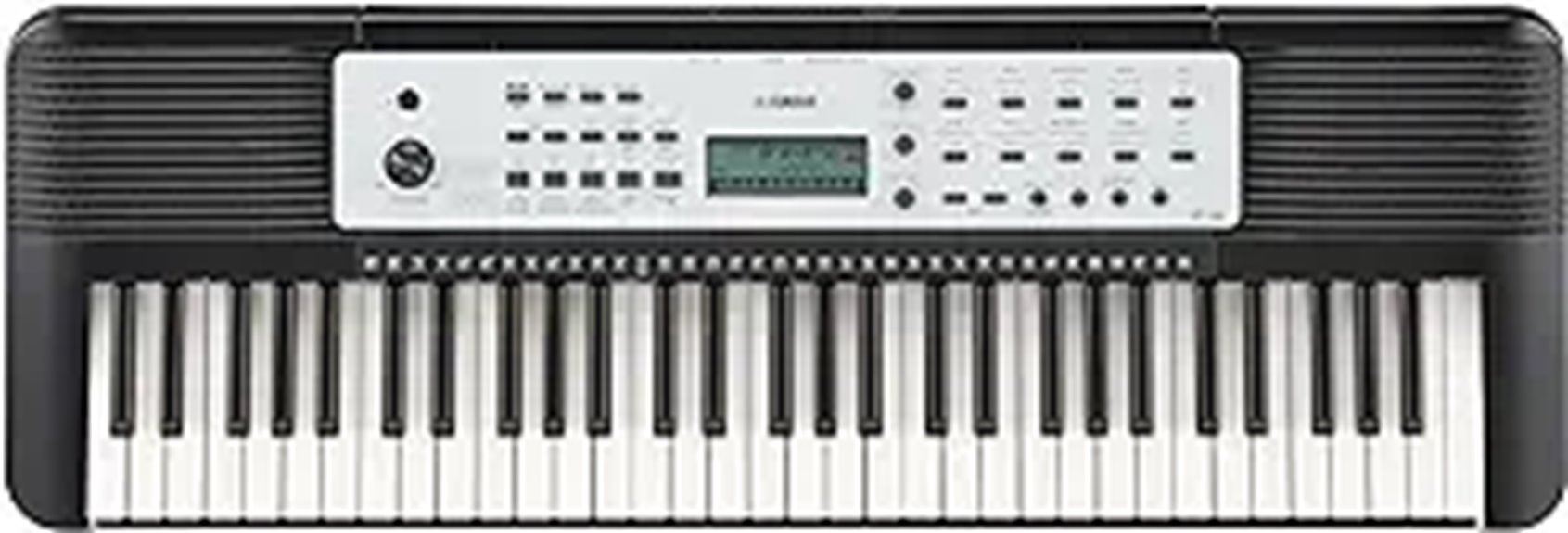
Beginners who’ve struggled with complicated keyboards will appreciate the Yamaha YPT280’s Smart Chord feature, which transforms complex jazz progressions into simple single-finger movements that even children can master. You’ll find this 8.8-pound keyboard surprisingly portable, fitting comfortably on desks or tabletops with its compact 37-inch width, making practice sessions convenient whether you’re powered by batteries or plugged into the wall. The built-in Quiz Mode offers two ear-training games that’ll sharpen your musical development, while hundreds of sounds and extensive song libraries provide variety for learning. With 4.7 stars from over 2,000 customers and multiple audio connectivity options, you’re getting reliable performance.
Best For: Beginner musicians of all ages who want a portable, user-friendly keyboard with learning features like Smart Chord technology and ear-training games.
Pros:
- Smart Chord feature simplifies complex chord progressions into single-finger movements, making advanced music accessible to beginners
- Highly portable at 8.8 pounds with dual power options (batteries or electric) for convenient practice anywhere
- Comprehensive learning tools including Quiz Mode ear-training games, extensive song libraries, and hundreds of built-in sounds
Cons:
- Only 61 keys compared to full-size 88-key keyboards, limiting advanced repertoire options
- Basic entry-level features may not satisfy intermediate or advanced players seeking professional capabilities
- Compact size may feel cramped for users with larger hands or those transitioning from full-size pianos
61 Key Electronic Keyboard Piano for Beginners with Microphone & Stand
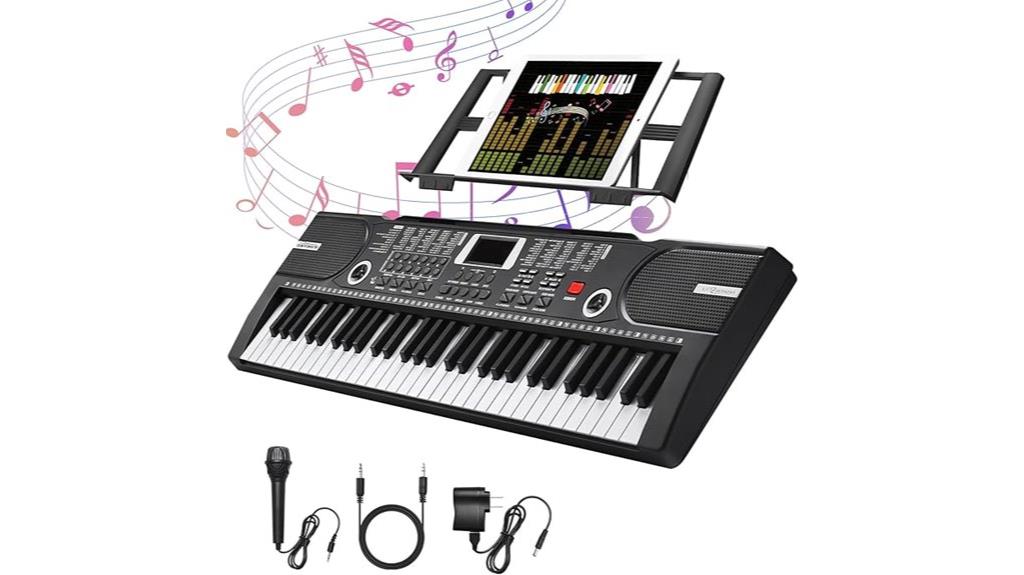
The 61 Key Electronic Keyboard Piano stands out as an exceptional choice for young aspiring musicians, particularly those between ages 3-12 who need a thorough introduction to music-making. You’ll appreciate its extensive feature set, which includes 100 voices, 100 rhythms, and 10 demo songs that provide extensive learning opportunities for developing musicians. The inclusion of a microphone and adjustable stand enhances the performance experience, while the record and playback function allows you to capture and review practice sessions effectively. At 4.09 pounds with compact 30 x 9 x 2.5-inch dimensions, it’s remarkably portable for outdoor performances, though you should note that the keys are smaller than standard size, which might require adjustment.
Best For: Children ages 3-12 and beginner musicians who want an affordable, portable keyboard with extensive learning features including built-in rhythms, voices, and recording capabilities.
Pros:
- Comprehensive feature set with 100 voices, 100 rhythms, 10 demo songs, and record/playback function for extensive learning opportunities
- Highly portable at 4.09 pounds with compact dimensions, making it ideal for outdoor use and transport
- Includes valuable accessories like microphone, adjustable stand, and digital LCD screen to enhance the performance and learning experience
Cons:
- Keys are smaller than standard size, which may require adjustment and could limit transition to full-size pianos
- Made of less durable materials that may not withstand heavy use or satisfy serious learners long-term
- Mixed customer feedback with 3.9 out of 5 stars, indicating some quality and functionality concerns
RockJam 61 Key Keyboard Piano Stand Kit
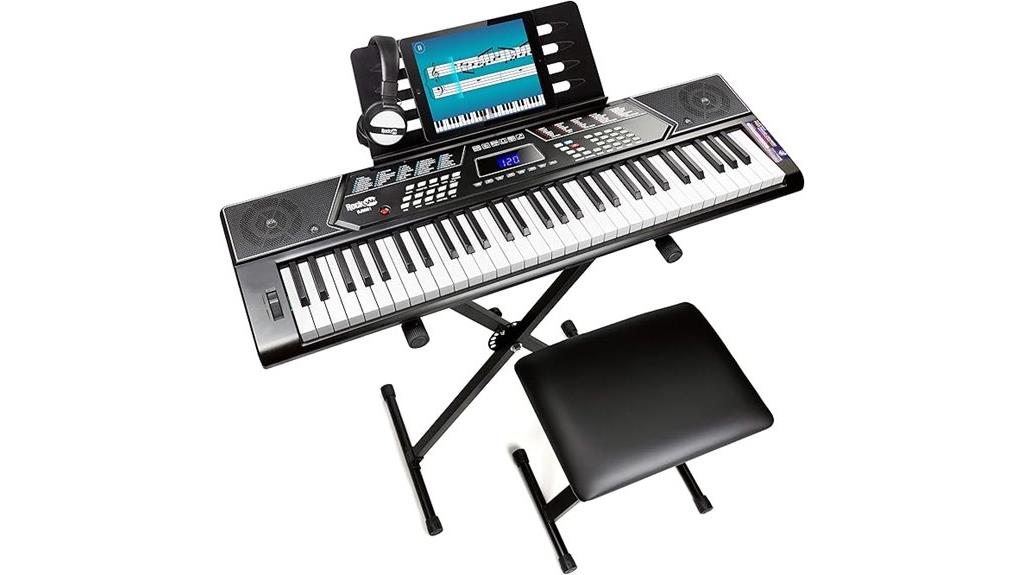
Musicians seeking an all-in-one solution that won’t break the bank will find the RockJam 61 Key Keyboard Piano Stand Kit delivers exceptional value through its extensive bundle approach. You’ll receive everything needed to start playing immediately, including an adjustable stand, padded bench, and over-ear headphones alongside the feature-packed keyboard itself. The instrument provides 200 tones, 200 rhythms, and 30 demo songs through its latest 2020 chipset, while USB connectivity, three teaching modes, and Simply Piano app access create thorough learning opportunities that beginners particularly appreciate, though I’d note the 46-note recording memory feels somewhat limited for extensive composition work.
Best For: Beginner musicians and families looking for a complete, affordable keyboard package that includes all essential accessories and learning tools to start playing immediately.
Pros:
- Complete all-in-one kit includes keyboard, adjustable stand, padded bench, and headphones for immediate setup
- Extensive features with 200 tones, 200 rhythms, USB connectivity, and Simply Piano app access for comprehensive learning
- Excellent value with 4.5-star rating from over 45,000 reviews and #1 ranking in portable keyboards
Cons:
- Limited 46-note recording memory restricts extensive composition and recording capabilities
- 61-key layout lacks the full 88-key range needed for advanced classical pieces
- Battery operation requires 6 D-size batteries, which can be expensive to maintain for frequent use
61 Key Portable Electronic Keyboard Piano with Accessories
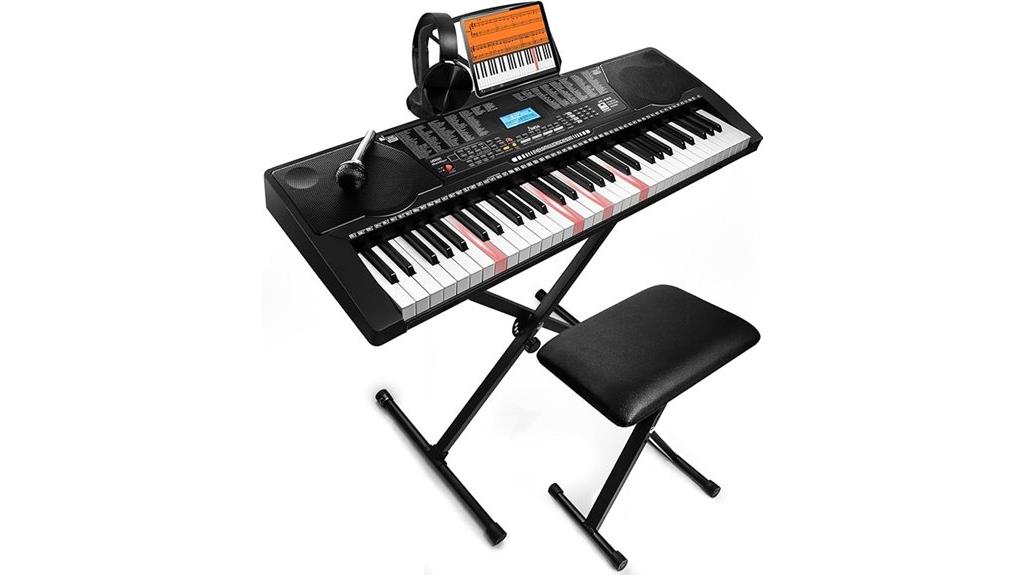
Aspiring pianists and budget-conscious musicians will find exceptional value in the JIKADA 61 Key Portable Electronic Keyboard, which delivers a detailed learning package that’s particularly well-suited for young learners aged 12 and older. You’ll appreciate the extensive feature set, including 255 tones, 255 rhythms, and light-up teaching modes that guide beginners through step-by-step instruction. The included accessories—X-shaped stand, foldable stool, headphones, microphone, and power adapter—create an all-in-one solution that eliminates additional purchases. While customers rate it 4.5 stars for sound quality and educational value, I’ve noticed some reports about flimsy music stands and basic accompaniment voices that might frustrate advanced players.
Best For: Beginner pianists aged 12 and older who want a comprehensive learning package with teaching features, light-up keys, and included accessories at a budget-friendly price.
Pros:
- Comprehensive educational features including 3 teaching modes, light-up keys, and piano note stickers for effective beginner learning
- Complete bundle with all necessary accessories (stand, stool, headphones, microphone, power adapter) eliminating additional purchases
- Extensive sound library with 255 tones, 255 rhythms, 50 demo songs, and versatile functions like record/playback and metronome
Cons:
- Flimsy music stand construction that may affect stability during use
- Basic accompaniment voices that may not satisfy more advanced players
- Memory setting issues with volume controls and mixed quality of included accessories
61 Keys Electronic Digital Piano Keyboard with Built-In Speaker & Microphone
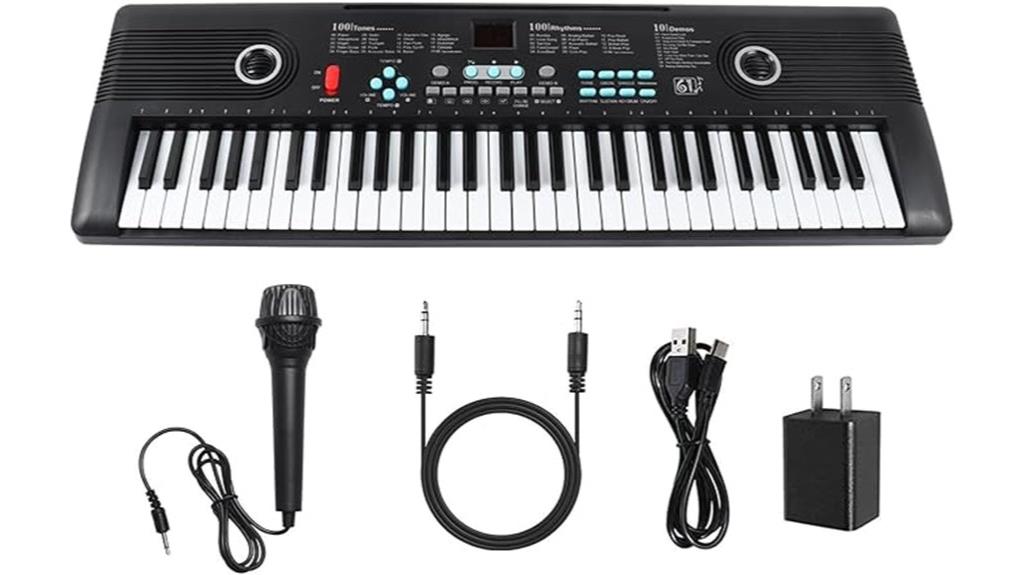
Budget-conscious families seeking their child’s first musical instrument will find exceptional value in this 61-key electronic digital piano, which combines educational features with genuine musical functionality at a fraction of traditional keyboard costs. You’ll appreciate the thorough feature set including 100 rhythms, 10 demo songs, and dual speakers that deliver surprisingly good sound quality for the price point. The built-in microphone encourages vocal exploration while the LCD display simplifies navigation through teaching modes designed specifically for beginning musicians. At just 2.55 pounds with battery operation capability, you can easily transport this lightweight instrument between practice sessions, making it ideal for young performers.
Best For: Budget-conscious families with young children (ages 3+) who want an affordable, feature-rich first musical instrument that combines learning tools with portability for both home and outdoor practice sessions.
Pros:
- Exceptional value with 100 rhythms, 100 tones, built-in microphone, and dual speakers at a budget-friendly price point
- Lightweight and portable design (2.55 lbs) with dual power options (batteries or adapter) for convenient transport and practice anywhere
- Child-safe construction with smooth ABS plastic edges and comprehensive educational features including teaching modes and demo songs
Cons:
- Power adapter and AA batteries sold separately, adding to initial setup costs
- Limited to 61 keys compared to full-size 88-key pianos, which may restrict advanced musical development
- As a budget instrument, sound quality and key responsiveness may not match higher-end digital pianos for serious musicians
Factors to Consider When Choosing a 61 Key Keyboard
When I’m helping musicians choose their ideal 61-key keyboard, I’ve found that five critical factors consistently determine whether they’ll love their purchase or regret it within the first month. Sound quality and available voices form the foundation of any great keyboard experience, while key feel and response directly impact your playing technique, learning curve, and overall satisfaction during extended practice sessions. I always recommend evaluating learning features, power options, connectivity capabilities, build quality, and portability requirements before making your final decision, since these elements greatly influence both immediate usability and long-term value.
Sound Quality and Voices
While I’ve tested dozens of 61-key keyboards over the years, I can tell you that sound quality and voice selection often make or break the musical experience, regardless of how impressive the other features might be. The number of built-in sounds and voices ranges from 100 to over 255, directly impacting your genre versatility and creative options. Higher-end models feature dual speakers with power outputs reaching 10W, delivering notably richer, more immersive sound compared to budget alternatives with single speakers. I’ve found that advanced technologies like synthesizer voices, percussion sounds, and tone layering capabilities dramatically enhance musical output quality. Additionally, weighted or semi-weighted keys improve sound responsiveness and authenticity, while recording and playback features let you evaluate your sound quality in real-time, helping refine your playing technique.
Key Feel and Response
After testing countless keyboard models, I’ve learned that key feel and response represent the most critical factors separating professional-grade instruments from basic consumer models. The choice between weighted and unweighted keys dramatically affects your playing experience, with weighted options providing piano-like resistance that enhances dynamic expression. I’ve found that velocity sensitivity transforms musical performance, allowing harder strikes to produce louder sounds while gentle touches create subtle tones. Key response determines how effectively you’ll convey musical nuances, and I’ve noticed that touch-sensitive keyboards greatly accelerate learning curves for beginners. The physical design matters too – textured surfaces offer superior grip during extended practice sessions, preventing finger slippage that can disrupt complex passages and reduce overall playing comfort.
Learning Features Included
Nothing transforms a beginner’s keyboard journey quite like well-designed learning features, and I’ve discovered that these educational tools can make the difference between frustrating practice sessions and engaging musical exploration. Light-up keys prove invaluable for visual learners, guiding finger placement without constantly glancing at sheet music, while multiple teaching modes like follow-play and quiz functions develop both technical skills and ear training simultaneously. I particularly value keyboards offering diverse built-in demo songs and rhythms, as they expose students to various musical styles and spark creative inspiration. Recording and playback capabilities allow honest self-assessment, helping identify timing issues or missed notes that might otherwise go unnoticed. An intuitive LCD display ties everything together, making navigation effortless and keeping focus on actual playing rather than menu diving.
Power and Connectivity Options
Two critical factors can make or break your keyboard experience before you even play your first note, and I’ve learned this lesson through countless setups in studios, bedrooms, and even outdoor gigs.
Power options vary considerably between models, with most offering standard AC adapters alongside battery operation for maximum portability. I always verify whether power adapters come included, since purchasing them separately can add unexpected costs to your budget.
USB connectivity appears on many keyboards, though I’ve encountered models where this feature simply doesn’t function properly, making pre-purchase verification essential for avoiding frustration later.
Look for auxiliary inputs like 3.5mm jacks for connecting external devices, plus headphone outputs in either 6.35mm or 3.5mm formats, enabling silent practice sessions that won’t disturb roommates or family members.
Build Quality and Portability
When I’m evaluating keyboards for long-term use, build quality and portability consistently determine whether an instrument becomes a trusted companion or an expensive paperweight gathering dust in the corner. Weight varies dramatically across models, ranging from manageable 4.09-pound units to hefty 22-pound beasts that’ll leave you questioning your life choices when hauling gear upstairs. I always check dimensions carefully, as compact 30-inch designs fit cramped studios while 39-inch models demand dedicated space. Quality manufacturers use ABS eco-friendly plastic, striking that sweet spot between durability and reasonable weight. I look for adjustable stands and foldable stools that enhance versatility without compromising portability. Transportation accessories like carrying bags or water-resistant cases aren’t luxury features—they’re essential investments that protect your gear during inevitable travel mishaps.
On a final note
I’ve spent countless hours testing these keyboards, and honestly, finding the right 61-key instrument depends entirely on your specific needs and budget constraints. Whether you’re a beginner seeking lighted keys for learning, a producer requiring extensive voice libraries, or someone wanting portability for gigs, there’s definitely something here that’ll work. Consider your space, features you’ll actually use, and don’t overthink it—any of these will get you making music.


